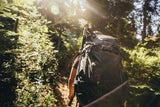Your Cooler Can Help Keep Food From Freezing When Winter Camping

Our expert guide for keeping your food from freezing while camping in cold temperatures.
Here we are—at the heart of another great winter camping season, and we'd like to share a few tips we've learned for making it a great time of year for outdoor adventure. And don't worry— you won't have to buy an entirely new setup to enjoy the benefits of winter camping (like fewer people, fewer bugs, and more solitude). Instead, adjust your established fair weather gear for the additional challenges of frigid temps, wintry terrain, and a frequently changing climate. For example—we are turning the ultimate summer staple, the cooler, into a food freeze fighter.
Yes, coolers are designed to keep things cold. Their primary purpose is to hold ice for days at a time and keep your drinks at a refreshing temperature. But the same insulation that helps maintain a cold micro-climate in the summer can help create a warm one for winter.
How does it work? Coolers have insulation that stops the heat from outside getting into the cooler to keep ice from melting; the same works to stop heat from leaving through the cooler's walls. So instead of adding ice to keep the cooler cold in the summer, we are adding heat to keep things warm. The trick is adding hot items to the cooler, like an insulated bottle with hot water or a heated rice sock. These are excellent for retaining heat because you can always boil more water for your insulated bottle or heat your rice sock as needed at camp to prepare your cooler for nightfall.

It depends on the size and density of the food, the size and quality of the cooler, external conditions, and any external heat sources you add to the cooler. Of course, any cooler, even styrofoam, is better than leaving food out in the cold. But the higher the quality, the longer it will stay at the ideal temperature, like 60 Quart Super Coolers. This cooler has a freezer-quality lid gasket and 3 inches of foam insulated walls. This same insulation will help you maintain your warm micro-climate for longer. In addition, this cooler's construction allows it to withstand whatever winter weather challenges you throw at it.
When you add hot items to your cooler, the thick insulating walls stop that heat from escaping the cooler to the external air—resulting in the inside of the cooler warming and keeping your food warm for longer. No, coolers aren't perfect at trapping heat, so your food will slowly decrease in temperature over time, but with a few tricks, it's a great space to keep your food or beverages from freezing.

Tips to Insulate Your Food Before Setting Out
A large part of winter camping food storage is performed while making preparations before setting out for camping. Here are a handful of tips you should follow before you leave to protect your food better.
- Grab An Insulated Thermos
Whether you're heading to the worksite with lunch or on a hike with coffee, you can't skip the thermos. Though it is generally considered a container for liquids, it's also great for storing any food items. Insulated thermoses are a must for food with even a little water content. Otherwise, there is a good possibility your food will freeze before you even reach your destination. In addition, a good quality insulated thermos provides excellent insulation for foods and drinks, as their specially prepared to do that job.
- Surround with Hot Water Bottles
This is so easy to do and one of the best ways to keep the inside of your cooler warm throughout your camping trip. When making breakfast in the morning, boil a pot of water, and fill the insulated bottles (like this one) with hot water. Repeat when making lunch and then again at dinner before you pack everything away for the night. Just like keeping your food and beverage cold in the summer by replenishing the ice, you need to do the same by refreshing your heat source. Encircle your foods with hot insulated water bottles. This will also help keep your water source from freezing, as well as your food.
- Use Socks or Gloves
Haven't got around to throwing out your old Smart-wool socks? Well, you did yourself a favor. If spare pairs of hiking socks or gloves are no longer in use, you can repurpose them into insulating food wrappers. Obviously, they will need to be clean because you don't want to risk your food getting contaminated with dirty socks.

Keep Your Cooler Closed And Latched:
Cascade Mountain Tech's Super Coolers are built with a freezer-quality seal that allows them to keep items cold for days on end, and as you've learned above, keep things hot. But the seal only does its job when the cooler lid is closed, and both latches are correctly sealed. So make sure to keep both rubber latches in place at all times when the lid is closed.
Keep It Covered:
Even though our coolers are built for long-lasting climate retention, the freezing temps are continually working to cool things down. Therefore, store your cooler in your trunk under an insulated blanket (like this one) to avoid as much direct exposure to cold temps as possible.
Use Cooler Locks To Keep Bears Out:
Contrary to popular belief, bears don't just disappear to their caves all winter long. If you live or camp in areas where bears are native roamers, you're probably aware of how skilled they are at getting into food storage containers. Our Super Coolers have been rated as bear-proof by the Interagency Grizzly Bear Committee, but cooler locks must be kept in place for them actually to live up to that certification. So make sure to lock up your cooler before bed or before venturing out of the campsite.
There you have it, tips on using your cooler to keep your food from freezing at camp. You don't have to settle for freeze-dried food all winter long. Especially because a hearty meal with loads of calories is vital to winter adventuring, so grab some thermoses, a few blankets, an old pair of hiking socks, and pack the cooler. Your winter camp awaits.

SHOP THE GEAR USED IN THIS ARTICLE:









